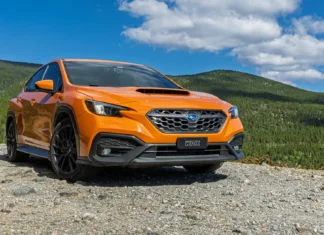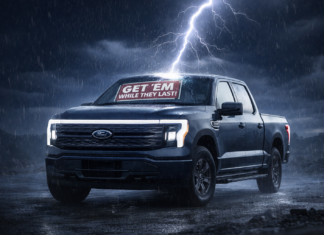
In this week’s Ask Nathan:
- Minivan wars!
- Battery electric vehicle cost curve?
- Towing a electric travel trailer?
The first question comes from a fan who remembered my warning that a minivan war is coming. She’s need a recommendation.

Q: Minivan War! (AskNathan@TFLCar.com) I’m a single mom with three little boys and I live in Northern California.
After over 12 years and 200,000 miles, I am ready to retire my beloved Betty Boo minivan. She’s a 2009 Nissan Quest and I utterly adore her. Over the 12 year love affair, Betty Boo has rarely had any problems. I calculated that she’s cost me say $5,000.00 in service and repairs, other than tires. That includes a very expensive service I did when her warranty passed. She was the best car I ever owned.
My mechanic said the transmission is failing and that it will cost more than the van is worth to repair. I should mention that Betty Boo got her name because she was rear ended in 2014 and has a boo boo that I never fixed. So she’s not worth much. There’s a glitch with some of the electronics like the windows too. The point I am making is that I feel I got my monies’ worth.
Now it is time to say goodbye and I decided to buy a brand new minivan.
I love the logical way you talk about minivans and how capable they are. Many reviewers talk about how boring having a family mover is, but you managed to see the good in these vans. Thank you!
So now you know my story! I ‘m in the market for a new minivan and I want to get the most for my dollar. I was pre-approved for $45,000, but I want to spend a lot less than that. A broker who promised me to find prices that are at or maybe below MSRP. Other than my fee, I am hoping to pay closer to $40,000. I know Nissan no longer builds minivans, so I need something that will replace my Betty Boo’s utility and reliability. I am thinking that having 4 wheel drive might be a good thing because my eldest snowboards competitively and, in Northern California we get nasty weather sometimes.
Nathan! Can you help a girl out and give me your impression of the best minivan for my money? My brother turned me onto your and your crew a while back and I love many of your channels. I listen to the podcasts and love watching your funny antics too! I seem to remember an older story where you mention that it’s going to be a minivan war. Is that now?
Nathan, If it were your money and you had three kids, and dogs, sports and camping, where would your money go? I should mention that I never tow and I’m not loyal to any brand.
— Nancy

A: Ah, the Minivan war is heating up!
This is a great time to be spectator on the sidelines of the current minivan war, but not if you’re buying. I’m delighted to hear that you’re promised close to the MSRP on these vehicles! Right now, crossovers/SUVs and pickup trucks are seeing astronomical price increases. In some cases, we even cover these price hikes.
Anyway, I am happy to hear that you and your brother like our content! Now, let’s talk about minivans and what’s out there that matches your price point.
Currently, there are five minivan options available in our market. Out of these five, you will find very different packaging and drivetrain combos for under $40,000. When I researched these vans, I tried to get the most out of the trim level, while providing (at the very least) heated seats, and accommodations for at least six. I listed them below, with their MSRP, from lowest to highest.
Ford Transit Connect Titanium Passenger Wagon – about $35,000
Kia Carnival LX (w/seat package) – about $36,000
Honda Odyssey EX – about $37,000
Toyota Sienna AWD LE – about $37,000
Chrysler Pacifica Touring – about $39,000
Here are some important notes about all five minivans:

Ford Transit Connect
While it is the least expensive minivan here, it also offers the least amount of seating (six) and, it’s the most primitive. Think of the Transit Connect as a cargo van that was converted into a passenger van for basic hauling duties, and you’d be on the right track. Still, it’s a handy size, inexpensive – and the powertrain is pretty good.
Kia Carnival
The Kia Carnival is as close as you can get to the feel of a crossover/SUV in a minivan. Even the base models come very well equipped, and they all benefit from a strong powertrain. It drives like a mid-size crossover – despite being one of the larger minivans. It also feels premium for the price. Like all Kia vehicle’s, the Carnival comes with an outstanding warranty too.

Honda Odyssey
While the Odyssey puts out a little less horsepower than the Kia Carnival (280 vs 290), it feels more athletic. Not only does the Odyssey have outstanding acceleration, it is the most athletic out of this group. It also offers competitive cargo and seating space, along with one of the more pleasant driving positions out there, at least for taller people.

Toyota Sienna AWD
At the price-point you preferred, this is the only minivan that allows you to get all-wheel-drive. On top of that, all Toyota Sienna’s come standard as hybrids. It is, by far, the most fuel efficient minivan (35 mpg combined) in this price bracket. I am very fond of its trick, electrically-powered rear end. It is a fine people mover, but you lose a lot of cargo space compared with the others. It’s also nowhere near as athletic as the Honda, nor as compliant as the Kia. Still, it’s a brilliant vehicle in its own right.

Chrysler Pacifica
Chrysler gives you a lot of choices: you can get a plug-in hybrid, an AWD van, or a normal front drive minivan – which is the only one that is in this price bracket. Sadly, the AWD option’s base price is much higher – as is the plug-in hybrid model. That’s a shame, because the AWD version is a great ride. As it is, the Chrysler Pacifica I highlighted still offers stow-n-go seating, which provides a completely flat loading floor. It is a very comfortable ride, and it has the highest quality interior too.

My personal choice? The Toyota Sienna LE AWD wins the minivan war.
As good as all of these minivans are, the fact that a minivan can get 35 mpg, have all-wheel drive and comes in well under $40,000 makes it a winner for me. Living in Colorado, constantly contending with winter conditions, and living on a tight budget – well, it makes this van a no-brainer. My second choice would probably be the Kia Carnival as it is such a pleasant overall package.
I hope this helped!
— N
The next question comes from a fan who feels that journalists are omitting the BEV cost curve over time.
Q: (AskNathan@TFLCar.com) BEV cost curve – are auto journalists deliberately obtuse?
Apologies for stealing Andy’s line from “The Shawshank Redemption”.
I’ve noticed a consistent trend in auto journalism. Fair journalists will mention that BEVs are on a cost curve to cost the same (to manufacture) as ICE vehicles sometime around mid decade (the year doesn’t really matter). And it almost seems as though they have a psychological block against taking the next step and saying “And after that BEVs will increasingly cost less (to manufacture)”.
Why is that? Or am I just imagining it? And this isn’t aimed at any one journalist, or any one site. It seems like an industry-wide phenomenon.
Thanks TFL!
— Scott from Asheville

A: Good question Scott – and there’s a lot of resistance to your conclusion.
Several outlets point out that their research suggest that BEVs (battery electric vehicles) will remain more expensive to produce than internal combustion engine vehicles for many years to come. I’m quoting this Financial Times article, “Electric cars will remain significantly more expensive for European carmakers to produce than combustion engine models for at least a decade, according to new research.”
That, and other similar articles were quoted by GreenCar Reports, InsideEVs among others.
On top of those articles, many journalists and automotive outlets still feel that BEVs are a waste of money. Some state that the battery degradation alone is enough of a reason to discredit BEV’s cost. Others bring up sustainability issues, along with consumer choice. Sure, you may not agree – but these are valid points.

On the other hand, there are quite a few outlets that agree with you. They feel that by 2025, BEVs will cost less than ICE vehicles to produce. Those outlets include Bloomberg, Self.inc and the EU’s Transportation & Environment Organization. All of which display their findings that BEVs should be much less expensive to build and own over the long run.
Many will agree with these points as well, but not everyone.
My personal opinion: I simply think it’s a matter of time. Once GM goes all-in on BEVs, along with Ford, Volvo and many others, production costs will eventually come down. As battery tech improves along with alternative materials, it will bring prices down significantly. New manufacturing processes will also help to lower production costs.
Thanks for the email!
— N
The last question comes from a mysterious email I received from – someone – who had some questions about the future of towing with an electrically powered travel trailer.

(Via: Twitter@NathanAdlen) Towing with EVs suck.
If you have a trailer that has its own power and could supply power it could help. It could have a motor to make way less strain and a big battery to help the EV. Why hasn’t anyone thought of this?
— “Someone”
A: There are a few companies that are working on it right now.
Airstream’s E-Stream concept
Airstream’s concept is called the E-Stream, and it is a fully function concept/prototype that was built to explore these technologies. Eventually, Airstream will build a production version of some sort, which is expected to be based on the findings of E-Stream. It has a power and regenerative system that’s similar to a modern EV.
This is a real cool idea, but it looks remarkably expensive too. You can read about the details at Airstream’s website.
Not only does it use automotive EV power to propel it behind the tow vehicle, it can move on its own. If you want it to park itself, without being backed in, it can. On top of that, it has a big lithium ion pack that can be charged, and provides a charge off-grid. It works with any standard charger, but I couldn’t find out if it will accept fast charging.
Dethleffs E.Home caravan

Similar in concept, but not as large, or extravagant as the E-Stream, the E.Home caravan is German-based RV builder Dethleffs’, serious attempt at an EV-powered trailer. The E.Home trailer comes with two 40 kWh batteries and two electric motors each rated at 30 kW. Like the E-Stream, its batteries are contained within the inner frame.
The bottom line is, your idea has been shared by a few RV builders over the past few years. It’s quite possible that we will see variations of these and other electrically assisted trailers in the near future. I am excited seeing some of the performance numbers. All towing creates power-sapping loss. That’s true with internal combustion engines too, but battery-electric vehicles suffer a much higher percentage of power loss. We’ve see this in person with all of our towing tests.
If a trailer can propel itself, reducing its pulling weight to a few hundred pounds, it would be a boon for electric and non-electric vehicles alike. I can’t wait to test one!
— N
Speaking of towing with an electric vehicle…























